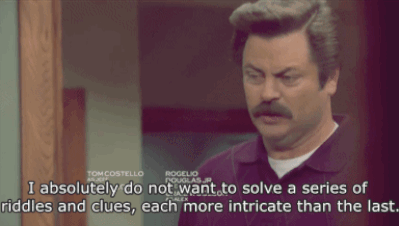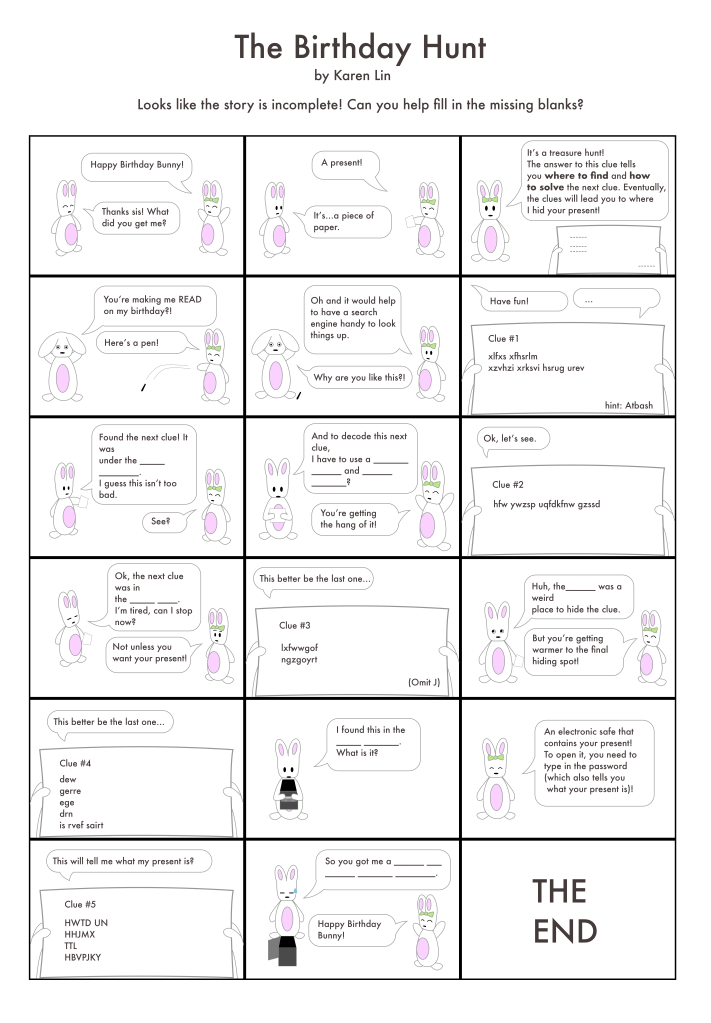
Recently, I’ve discovered how important puzzles are in my life. When I decided to try writing a game, I was immediately overwhelmed by how to start. Do I begin with gameplay, characters, world-building, or something else? Then I realized that my favorite games revolve around logical problem-solving, so I should begin by researching the art of making puzzles.
To start with what I know, I mined my past for examples of games and puzzles I’ve enjoyed. From there, my goal was to draw on my own experiences and leverage my existing writing/design skills to create a set of puzzle-writing guidelines.
Some examples of puzzles in my daily life
First, I had to figure out what counts as a puzzle. I like Wikipedia’s definition of “a game, problem, or toy that tests a person’s ingenuity or knowledge . . . Puzzles are often created to be a form of entertainment but they can also arise from serious mathematical or logistical problems.” The National Puzzlers’ League also offers the examples of cryptograms, crossword puzzles, and anagrams. With those definitions in mind, here are some puzzles I enjoy:
- Mechanical puzzles: I admit to being a jigsaw puzzle addict. I love discovering each part of a picture in intimate detail, starting from the edge pieces to the middle. I know what the end result should look like, but I don’t know how long it will take me to get there. I also think of rock climbing as a type of physical puzzle; getting my body up the wall is a problem unique to my physique and strength.
- Logic Puzzles: A college friend once assured me that I would enjoy law school, because I’m a logical person (is that a logical assumption?!). I’m not touching law school with a ten foot pole, but I do enjoy LSAT questions, classic logic grid puzzles, and discovering answers through the process of elimination. I also like solving the occasional computer science programming question.
- Cryptic puzzles: Steven Clontz’s blog defines cryptic puzzles as “‘designer’ puzzles which are meant to be solved at most once by a given person, since part of the puzzle is the epiphany required to see an extraction technique.” These are often used in escape rooms and puzzle games. For example, the mobile game Lumino City presents their puzzles as part of a story with minimal hints on how to solve them. Unfortunately, cryptic puzzles are hard to write, since each one is meant to be solved only once.
- Word Puzzles: I used to compete with my friends to see who could finish the daily New York Times crossword puzzle with the lowest time. Crosswords are a gold mine of puns and double meanings. For example, the clue “They’re tired and stay in a lot,” might lead you to think of a “lazy person who frequently sleeps in.” Lo and behold, the answer is actually “cars.” My favorite solutions also play with the visual space and orientation of the words, like the WEAVE solution here:

- Codes and Ciphers: Thanks to The Da Vinci Code, I was fascinated with codes and secret organizations when I was younger. I’d send my friends messages using the Caesar Box cipher and other encryption methods. I love the idea of writing information that no one can decode unless they have the secret key. It still fascinates me that the outcome of wars and bank security rely on how well our messages are encrypted. Hats off to spies and computer security experts.
Side note: I want to distinguish puzzles from riddles, which are often open-ended and don’t have set solutions. However, riddles can also subvert your expectations and play with double meanings of words. For example, “what’s round with a tail?” Your first thought might be an animal with a tail, but the answer is actually a penny!
Puzzles as part of a larger story
The beauty of puzzles is that they can be standalone, or strung together into a cohesive story or game. They can increase in difficulty with each level and move plots along in a story. Here are examples I’ve enjoyed:
- Scavenger hunts: When I was younger, I hid my brother’s birthday present every year and made him solve a series of clues until he unearthed the hiding place (imagine my delight when Leslie Knope did the same for Ben Wyatt in Parks and Recreation). I wish I’d saved the hints I’d written, but they’re tragically lost in time. I’m not sure my brother enjoyed working so hard to get his birthday present, but I sure enjoyed designing the hunts.

- Escape rooms: Being physically locked in a fictional story and solving a combination of logic and mechanic puzzles is my favorite pastime. There was a golden period a few years ago when I played through multiple escape rooms with friends and documented each puzzle I encountered. Escape rooms are still my favorite of example of interlocking puzzles that work together to create a narrative.
- The Legend of Zelda: I’m indifferent about fighting monsters, but I love solving dungeons and experiencing the world of The Legend of Zelda. It’s the video game version of escape rooms, except you get to use special powers you don’t have in real life.
- Danganronpa: I’ve been playing this (NSFW!) murder mystery anime-style interactive novel. The main mechanic of the game is to collect evidence after each murder, then use the evidence to poke holes in others’ arguments during the trials. It’s the ultimate combination of story and logic puzzle.
- Novels: I love stories where characters solve puzzles that advance the plot, and readers can figure out the mystery along with the protagonist. I adore The Da Vinci Code not for its prose, but for its treasure hunt plot. I especially love the potion puzzle Hermione has to solve at the end of Harry Potter and the Sorceror’s Stone. It drives home the point that logic can be just as valuable and challenging as magic when evaluating a wizard’s strengths.
Techniques for writing puzzles
Let’s move on to the implementation. What makes a good puzzle? If there’s a series of them, how do you keep them consistent and challenging? Here are some of my thoughts:
- Make sure the end goal is clear. For example, the goal in a scavenger hunt is to either find the treasure or the final destination.
- The puzzle needs to be fair, meaning that it follows a logical if-then progression and has at least one definite solution. I’ve played puzzles that required me to stretch my brains in ways that didn’t make sense, and my frustration made the experience unsatisfying.
- Have a mental model of your audience. When the player encounters a phrase or image, you can anticipate their typical gut reaction and subvert expectations.
- Give players the right tools to orient themselves. Zelda provides maps to consult in case you get lost in a dungeon. Logic puzzles provide grids so players can visualize the process of elimination. If the player feels too lost, they won’t have very much fun.
- Make creative use of the medium, whether it’s audio, visuals, 2D, 3D, virtual reality, or physical space. If there’s a team, make them communicate and collaborate in unique ways.
Putting together the pieces
As I was writing this article, some elements jumped out at me:
- My love for ciphers
- Puzzle solutions containing the key to solving the next puzzle
- Memories of creating scavenger hunts for my brother
- Puns and double meaning
- My propensity for drawing bunny-themed comic strips (most notably a comic series called Doggy and Bunny that I created with my friend in sixth grade)
With that in mind, I present The Birthday Hunt:

Here are some ways I could improve the experience of The Birthday Hunt:
- The comic doesn’t provide you with tools to learn the methods required to solve each clue. If the game were more interactive, I could build a teaching tool instead of asking the player to keep a search engine handy.
- The last gimmick with the safe box didn’t fit into the story as naturally as I wanted, and I would have found an alternative story device, given more time.
Takeaways
Writing this article and the accompanying comic-puzzle felt like solving a jigsaw puzzle; I didn’t know what the finished picture would look like when I started, but I had to trust myself that it would come together. I kept brainstorming until each piece became clearer and clearer.
I also put a lot of pressure on myself to create something fun, even though I know the definition of “fun” is not the same for everyone. It was certainly fun for me to create a story that drew on my life experiences. I have so much respect for puzzle writers who can create universally beloved games.
Solving puzzles and completing challenges together is a great way for people to connect. I saw this in action as I watched a mom entertain her young son with riddles while waiting to board an airplane. I’m excited to learn more about the process of making puzzles and games, hopefully in a more interactive medium than a comic strip (and with more bunnies).
This puzzle was fun 🙂
You mentioned you didn’t provide a lot of info about how to do the puzzles, but I considered that part of the fun. Tracking down more info or finding a good decoder was fun in and of itself
LikeLike
Thanks for the feedback Juan! 🙂
LikeLike